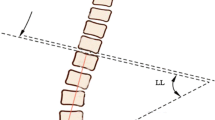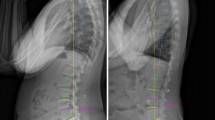Abstract
Purpose
Previous studies did not specifically assess the influence of proximal femoral angle (PFA) on sagittal balance in high-grade spondylolisthesis (HGS). In addition, the relationship between PFA and quality of life (QOL) remains unknown. This study determines if increased PFA is associated with decreased QOL and sagittal balance in lumbosacral HGS.
Methods
This retrospective case–control study was performed on a cohort of 56 normal subjects and 42 patients with HGS. Initially, PFA was measured twice by 3 raters in a random subset of 30 subjects (15 normal and 15 HGS) to determine the intrarater and interrater reliability of the measurement technique. PFA was then measured for all subjects. For the 42 patients with HGS, QOL was assessed from the SRS-22 questionnaire, in addition to the evaluation of the spino-pelvic balance.
Results
The intrarater and interrater intraclass correlation coefficients for the measurement of PFA were, respectively, 0.951 and 0.958, suggesting excellent reliability. PFA was significantly higher in HGS patients (8.3° ± 6.7°; range − 5° to 24°) when compared to normal subjects (3.0° ± 3.1°; range − 6° to 10°). The PFA in HGS was 5.6° ± 5.6° (range − 5° to 18°), 8.9° ± 6.7° (range − 2° to 24°), and 14.0° ± 6.0° (range 7°–23°) in type 4 (balanced pelvis), type 5 (unbalanced pelvis/balanced spine), and type 6 (unbalanced pelvis and spine) subjects, respectively. There were, respectively, 23.5% (4/17), 26.3% (5/19), and 83.3% (5/6) of HGS patients with abnormal PFA ≥ 10° in type 4, type 5, and type 6 subgroups. Increased PFA in HGS patients was related with deteriorating self-image, pain, function and total SRS-22 score, as well as with increasing pelvic tilt and decreasing sacral slope.
Conclusion
A PFA ≥ 10° is proposed as a criterion to define abnormal PFA. PFA was increased in HGS and increased along with deteriorating sagittal balance and QOL. PFA is a clinically relevant parameter of sagittal balance, and can be useful in the evaluation and management of patients with HGS.


Similar content being viewed by others
References
Mac-Thiong J-M, Wang Z, de Guise JA et al (2008) Postural model of sagittal spino-pelvic balance and its relevance for lumbosacral developmental spondylolisthesis. Spine 33:2316–2325
Li Y, Hresko MT (2012) Radiographic analysis of spondylolisthesis and sagittal spinopelvic deformity. J Am Acad Orthop Surg 20:194–205
Labelle H, Mac-Thiong J-M, Parent S (2018) Section 11—chapter 28—Surgery for pediatric spondylolisthesis. In: James M, Chapman M (eds) Chapman’s comprehensive orthopaedic surgery, 4th edn. Jaypee Brothers Medical Publishers, London (in press)
Labelle H, Mac-Thiong J-M, Roussouly P (2011) Spino-pelvic sagittal balance of spondylolisthesis: a review and classification. Eur Spine J 20:S641–S646
Hresko MT, Labelle H, Roussouly P et al (2007) Classification of high-grade spondylolisthesis based on pelvic version and spine balance: possible rationale for reduction. Spine 32:2208–2213
Phalen GS, Dickson JA (1961) Spondylolisthesis and tight hamstrings. J Bone Jt Surg Am 43:505–512
Shelokov A, Haideri N, Roach J (1993) Residual gait abnormalities in surgically treated spondylolisthesis. Spine 18:2201–2205
Ferrero E, Liabaud B, Challier V et al (2016) Role of pelvic translation and lower-extremity compensation to maintain gravity line position in spinal deformity. J Neurosurg Spine 24:436–446
Lazennec JY, Folinais D, Bendaya S et al (2016) The global alignment in patients with lumbar spinal stenosis: our experience using the EOS full-body images. Eur J Orthop Surg Traumatol 26:713–724
Mangione P, Sénégas J (1997) Sagittal balance of the spine (article in French). Rev Chir Orthop Reparatrice Appar Mot 83:22–32
Obeid I, Hauger O, Aunoble S et al (2011) Global analysis of sagittal spinal alignment in major deformities: correlation between lack of lumbar lordosis and flexion of the knee. Eur Spine J 20(Suppl 5):S681–S685
Bourassa-Moreau E, Mac-Thiong J-M, Labelle H (2010) Redefining the technique for the radiologic measurement of slip in spondylolisthesis. Spine 35:1401–1405
Harrison DE, Harrison DD, Cailliet R et al (2001) Radiographic analysis of lumbar lordosis. Centroid, Cobb, TRALL, and Harrison posterior tangent methods. Spine 26:E235–E242
Koo TK, Li MY (2016) A guideline of selecting and reporting intraclass correlation coefficients for reliability research. J Chiropr Med 15:155–163
Gutman G, Joncas J, Mac-Thiong J-M et al (2017) Measurement properties of the Scoliosis Research Society Outcomes Questionnaire in adolescent patients with spondylolisthesis. Spine 42:1316–1321
Funding
No funds were received for this research.
Author information
Authors and Affiliations
Corresponding author
Ethics declarations
Conflict of interest
None.
Rights and permissions
About this article
Cite this article
Mac-Thiong, JM., Parent, S., Joncas, J. et al. The importance of proximal femoral angle on sagittal balance and quality of life in children and adolescents with high-grade lumbosacral spondylolisthesis. Eur Spine J 27, 2038–2043 (2018). https://doi.org/10.1007/s00586-018-5506-3
Received:
Revised:
Accepted:
Published:
Issue Date:
DOI: https://doi.org/10.1007/s00586-018-5506-3




